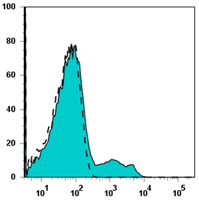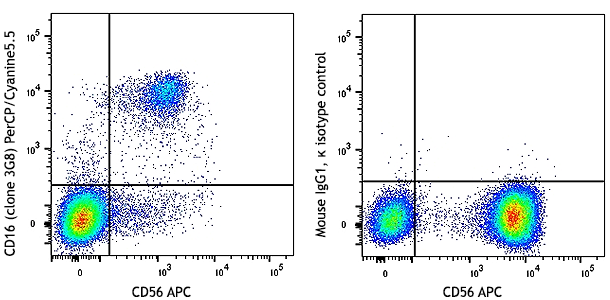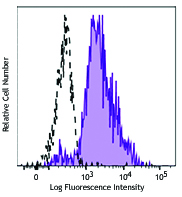- Clone
- LMM741 (See other available formats)
- Regulatory Status
- RUO
- Workshop
- VI MA98
- Other Names
- CSF3R, HG-CSFR, Colony Stimulating Factor 3 receptor
- Isotype
- Mouse IgG1, κ
- Ave. Rating
- Submit a Review
- Product Citations
- publications

-

Human peripheral blood granulocytes stained with LMM741 PE
| Cat # | Size | Price | Quantity Check Availability | Save | ||
|---|---|---|---|---|---|---|
| 346105 | 25 tests | $134 | ||||
| 346106 | 100 tests | $317 | ||||
CD114 is the receptor of the colony stimulating factor 3 (CSF3, G-CSF), consist of two 130 kD, type I transmembrane chains that form a homodimer. The extracellular domain consists of an immunoglobulin-like domain, a cytokine receptor homologue domain, and three fibronectin type III repeats. CD114 is expressed in all stages of granulocyte differentiation and in monocytes, platelets, endothelial cells, placenta and trophoblasts. The binding of CSF3, results in the activation of many signaling molecules such as Syk, Lyn, Jak1, Jak2, Tyk2, SOCS3, SOCS1, STAT5, and Shp1, resulting in the expression of different target genes that will increase neutrophil precursor survival, proliferation and maturation. In mature neutrophils, it increases survival, superoxide anion generation, arachidonic acid release, production of myeloperoxidase and leukocyte alkaline phosphatase (LAP).
Product DetailsProduct Details
- Reactivity
- Human
- Antibody Type
- Monoclonal
- Host Species
- Mouse
- Immunogen
- CHO cells transfected with hG-CSFR
- Formulation
- Phosphate-buffered solution, pH 7.2, containing 0.09% sodium azide and BSA (origin USA)
- Preparation
- The antibody was purified by affinity chromatography, and conjugated with PE under optimal conditions.
- Concentration
- Lot-specific (to obtain lot-specific concentration and expiration, please enter the lot number in our Certificate of Analysis online tool.)
- Storage & Handling
- The antibody solution should be stored undiluted between 2°C and 8°C, and protected from prolonged exposure to light. Do not freeze.
- Application
-
FC - Quality tested
- Recommended Usage
-
Each lot of this antibody is quality control tested by immunofluorescent staining with flow cytometric analysis. For flow cytometric staining, the suggested use of this reagent is 5 µl per million cells in 100 µl staining volume or 5 µl per 100 µl of whole blood.
- Excitation Laser
-
Blue Laser (488 nm)
Green Laser (532 nm)/Yellow-Green Laser (561 nm)
-
Application References
(PubMed link indicates BioLegend citation) -
- Layton JE, et al. 1997. Growth Factors. 14:117
- Layton JE, et al. 1999. J. Biol. Chem. 274:17445
- Layton JE, et al. 2001. J. Biol. Chem. 276:36779
- Gupta K, et al. 2014. Blood. 123:2550. PubMed
- Product Citations
- RRID
-
AB_1967117 (BioLegend Cat. No. 346105)
AB_2083867 (BioLegend Cat. No. 346106)
Antigen Details
- Structure
- Single chain type I transmembrane molecule of 130 kD. The extracellular domain consists of an immunoglobulin-like domain, a cytokine receptor homologue domain, and three fibronectin type III repeats. To function as a receptor, this molecules form a homod
- Distribution
-
Granulocytes (in all stages of differentiation), monocytes, platelets, endothelial cells, placenta and trophoblasts.
- Function
- Stimulates survival, proliferation, and maturation of neutrophil precursors. In mature neutrophils increases survival, superoxide anion generation, arachidonic acid release, production of myeloperoxidase and leukocyte alkaline phosphatase (LAP).
- Interaction
- Syk, Lyn, Jak1, Jak2, Tyk2, SOCS3, SOCS1, STAT5, Shp1.
- Ligand/Receptor
- CSF3(G-CSF)
- Bioactivity
- Stimulate the proliferation and differentiation of neutrophils precursors and the activation of mature neutrophils.
- Cell Type
- Endothelial cells, Granulocytes, Monocytes, Neutrophils, Platelets
- Biology Area
- Immunology
- Molecular Family
- Adhesion Molecules, CD Molecules, Cytokine/Chemokine Receptors
- Antigen References
-
1. Starnes LM, et al. 2009. Blood 114:1753
2. Skokowa J, et al. 2009. Nat Med. 15:151
3. Ai J, et al. 2008. PLoS One. 3:e3422
4. Germeshausen M, et al. 2008. Curr Opin Hematol. 15:332
5. Marino VJ, Roguin LP, et al. 2008. J Cell Biochem. 103:1512
6. Irandoust MI, et al. 2007. EMBO J. 2:1782 - Gene ID
- 1441 View all products for this Gene ID
- UniProt
- View information about CD114 on UniProt.org
Related FAQs
- What type of PE do you use in your conjugates?
- We use R-PE in our conjugates.
Customers Also Purchased
Compare Data Across All Formats
This data display is provided for general comparisons between formats.
Your actual data may vary due to variations in samples, target cells, instruments and their settings, staining conditions, and other factors.
If you need assistance with selecting the best format contact our expert technical support team.
 Login/Register
Login/Register 

















Follow Us